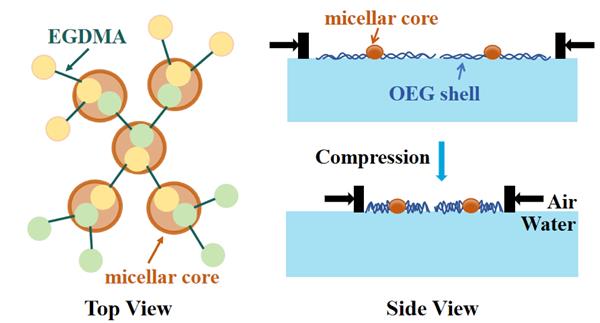35.【J. Phys. Chem. B】Ultrafine Network-like Monolayer Structures of Amphiphilic Hyperbranched Copolymers Revealed by the Relative Aggregation Number Method
作者:Yuqing Wei, Gangyao Wen*, Anastasia Balafouti, Stergios Pispas, Hongfei Li
关键字:Langmuir monolayer, LB film, hyperbranched copolymer, amphiphilic copolymer, network-like structure, aggregation number
论文来源:期刊
具体来源:J. Phys. Chem. B. 2024, 128(35), 8605–8612.
发表时间:2024年
The aggregation behavior of two amphiphilic hyperbranched copolymers of poly[oligo(ethylene glycol) methacrylate-co-lauryl methacrylate] (H-[P(OEGMA-co-LMA)]) at the air/water interface was investigated by using the Langmuir film balance technique and atomic force microscopy (AFM). At the air/water interface, H-[P(OEGMA-co-LMA)] copolymers spontaneously form the ultrafine network-like monolayer structures of micelles, and each micelle consists of a tiny hydrophobic core of one or two carbon backbones and lauryl side groups and a short hydrophilic shell of oligo(ethylene glycol) (OEG) side groups, and the micellar cores are connected by the branching agent ethylene glycol dimethacrylate (EGDMA). These ultrafine micellar structures are successfully revealed by our relative aggregation number method presented in this work, which is based on our previous relative mass method and methylene number method. The surface pressure-molecular area isotherms of POEGMA29%-PLMA71% (weight percent) and POEGMA69%-PLMA31% are condensed and expanded, respectively, because the density/number of OEG side groups in the former shells is smaller than that in the latter case. Upon monolayer compression, the isotherms of the former are classified into regions I-IV whereas those of the latter into regions II and III based on their different variation trends of surface pressure. Subphase pH has little influence on the isotherms of the two copolymers because the stretching degrees of hydrophilic OEG side groups in the shells are probably limited by the connected cores, which is different from the large effects in our previous block copolymers containing POEGMA or POEGA blocks. Under neutral and alkaline conditions, in region III, the mean molecular areas (mmA) of the isotherms of the two copolymers at 20 °C are smaller than those at 10 °C due to the collapse of OEG side groups above 15 °C. Furthermore, the isotherms of POEGMA69%-PLMA31% move to larger mmA at 30 °C due to the increased thermal mobility and stretching degrees of more OEG side groups.

Article address: https://doi.org/10.1021/acs.jpcb.4c03557.